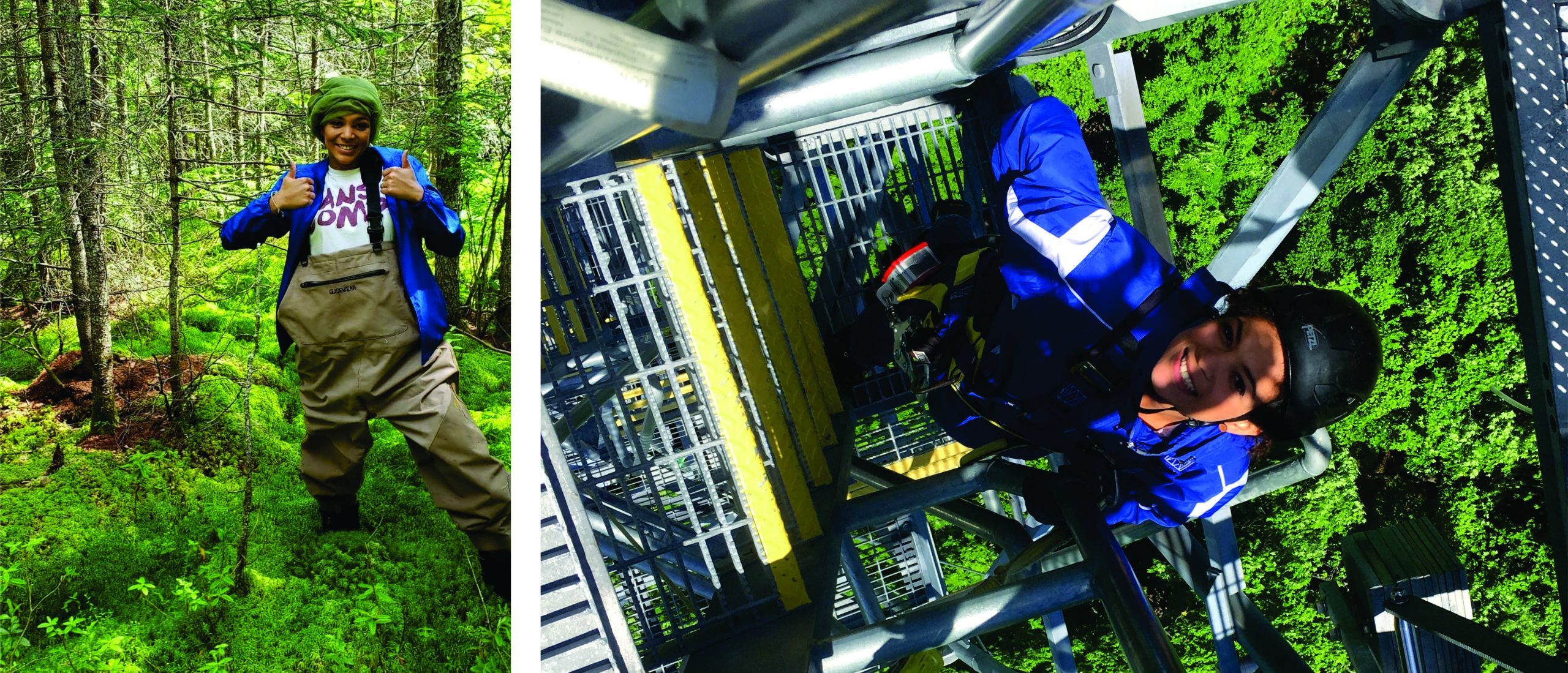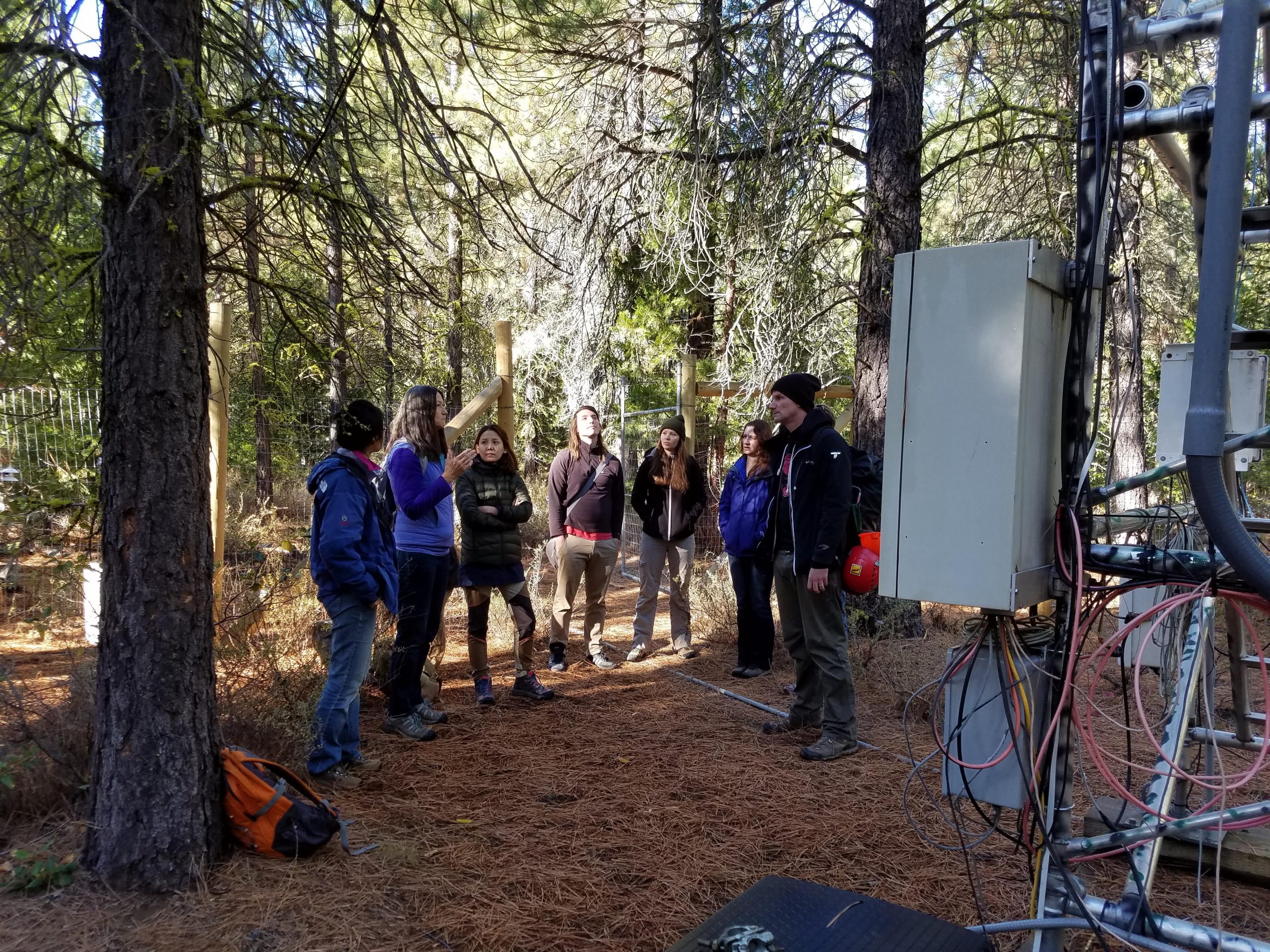AmeriFlux means a diversity of ecosystems, but also of people and personal narratives. Today, on the second Thursday in July, our Mexican members observe Día del Árbol (Arbor Day). What a great opportunity to meet a few of the talented, innovative women who work at AmeriFlux sites across the Americas!
AmeriFlux owes its success to the many excellent researchers and technicians at sites across North, Central and South America.
We spoke with Susana Alvarado from the Puerto Morelos Mangrove Flux site, Jess Turner from the University of Wisconsin-Madison, and Beverly Law from Oregon State University about their experiences in STEM fields. Though all these women have common interests–a collective love for nature, an appreciation for exploring, and a love for ecosystems science–they came to AmeriFlux from a variety of backgrounds.

Dr. Susana Alvarado cleans the radiometer of a flux tower, with the help of two colleagues, in a mangrove of Puerto Morelos, Quintana Roo (MX-PMm site)
Q1: Why did you become a scientist?
Susana: I am from Guatemala, where there is very little scientific research done. Growing up I never really thought of becoming a scientist; it was something completely foreign and almost impossible to achieve. I do remember daydreaming a lot about exploring mountains, volcanoes and jungles while taking drives with my family. So the short answer is that I became a scientist as the outcome of accepting all the opportunities I had to explore and learn.
I learned computer programming in middle and high school as my parents thought it was a good idea to set me up for a career in technology and I went with it because I enjoyed playing with the computer. By college I had the urge to travel and explore nature, so I enrolled in Forest Engineering, in part, because of all the field courses and trips. After graduating I accepted a job that consisted of traveling around Sierra de las Minas Biosphere Reserve and engaging local communities and governments in the protection of the cloud forest to preserve their water resources. While doing that, it occurred to me that it would be not only useful but very interesting to investigate more about the forest-water links. So after writing an email to scientists doing research in Costa Rica, pursuing a master’s degree in ecohydrology was on the radar and possible. And that’s how it all began, I went to Amsterdam (VU Universiteit) and then to Brazil to do my master’s thesis. Afterwards, I was invited to join a team of scientists working on a U.S.-funded project in Mexico as a doctorate student (University of New Hampshire). Thanks to that opportunity, a strong friendship and fruitful work relation started among several colleagues, which continues to this day. I stayed in Mexico where I did a postdoc (UNAM) and started my family. Currently, I am an associate professor at a public Mexican research institute (Instituto de Ecología in Xalapa, Veracruz), living the dream of doing what I love.
Jess: I think there are so many alluring aspects to the field of science. You could choose to study life at the bottom of the ocean, climatic events from millions of years ago, organisms from the microscopic scale to the massive, etc. I love science because I never have to stop asking “why.”
Beverly: I loved to be outdoors, and was curious about how ecosystems function. I grew up with the influence of my grandfather on learning birds of MN, and how ecosystems cycle carbon and nutrients.

Jess Turner at the Sphagnum Bog in Northern WI, on the NEON flux tower, and next to some stream equipment at Allequash Creek also in Northern WI
Q2: What is exciting you about science right now?
Susana: There are quite exciting things in ecohydrology, where my research is framed. I just finished teaching an intensive course introducing ecohydrology to graduate students of varied fields of ecology, and together we were fascinated about both the elegant simplicity of the water cycle, and the enormous complexity of the pathways water takes while circulating through the critical zone of the planet. Understanding how ecosystems function hydrologically (particularly water-use patterns) and the role of vegetation on regulating climate and precipitation is absolutely fascinating to me. Questions about water distribution among plants that create inter- and intraspecific root networks (such as mangrove species) is something I just recently came across, and I would expect pretty awesome developments from this research. I’m excited about developments on questions that are also very important for sustainable land management such as complimentary water (and nutrients) use of coexisting plants in agroforestry systems. Developments on how disruptions to hydrological connectivity in coastal ecosystems have impaired their functions up to mortality, and how restoration can be effective for massively degraded zones, are also exciting and much needed. Finally, as more and more measurements of land surface-atmosphere interactions are done and synthesized from tropical and coastal ecosystems such as mangroves, fascinating things will be learned to fill gaps needed to validate water and carbon pathways and allocation models.
Jess: I love how scientists and the interested public can interact through various social media platforms. I think it creates interesting discussion and opportunities to learn about other research going on in or outside of your field! I also appreciate that something as simple as searching for hashtags like #sciencetwitter can lead to internships, funding opportunities, and outreach.
Beverly: We have improved data analysis methods that allow us to combine many different kinds of data and modeling to understand future response to climate change and land use.
Q3: What is something unique that women bring to the science community?
Susana: I think the science community, as any other community, benefits from diversity, not only in gender, but in all walks of life. Any human enterprise benefits from all kinds of different minds (shaped by a world of different experiences) working together towards a goal. More diversity in any community brings different perspectives to the table and enriches the answers and solutions to problems.
Having said that, I do think that women in a science community have a positive impact on pushing the work environment towards adopting more sensible practices that pertain not only to women. For instance, issues related to a healthy work environment and family/work balance in particular, such as how academic institutions handle maternity leave and harassment. I think when women are part of the workforce, these issues are discussed more and eventually changes happen that benefit both women and men.
Jess: I think women can offer a different perspective on scientific issues and contribute new ideas because of their life experience and the influence that gender has on it. The benefits of women in STEM are many, but the difficulties for women in STEM are multifaceted so I think it is important to ensure that not only is there equal representation, but also that women have fair chances at other opportunities such as fieldwork, tenure, and publication.
Beverly: Women and many men see the value of working together towards common research goals. We can do much more as a community of scientists with diverse skills working together. The old model of stand-alone scientists, just doesn’t work with the large spatial scales and complex data analysis that is necessary to address regional to global issues like climate change impacts.


No Comments
Be the first to start a conversation